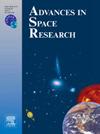Water quality hotspot identification using a remote sensing and machine learning approach: A case study of the River Ganga near Varanasi
IF 2.8
3区 地球科学
Q2 ASTRONOMY & ASTROPHYSICS
引用次数: 0
Abstract
Turbidity (Turb) and Chlorophyll-a (Chl-a) are crucial indicators of water quality because they can reveal the presence of suspended particles and algae, respectively. Understanding the health of rivers and spotting long-term water quality changes can both benefit from monitoring these measures. Traditional methods of monitoring these parameters, like in-situ measurements, is time-consuming, expensive, and inconvenient in some places. Sentinel-2, a multispectral satellite, might offer a more workable and economical option for monitoring water quality, though. This study used 100 in-situ data collected from the Ganga River near Varanasi in the pre-monsoon season (pre-MS) and post-monsoon season (post-MS) in order to create a model for the prediction of optically active water quality parameters by combining Multispectral Instrument (MSI) data and machine learning method (Random Forest). To create spatial distribution maps for Chl-a and Turb, 14 spectral indices and band ratios were employed as independent variables. The results showed that the prediction accuracy for Turb (R2 = 0.91, MAE = 1.13 and MAPE=7.76 % during pre-MS and R2 = 0.93, MAE = 0.88 and MAPE=2.29 % during post-MS) and for Chl-a (R2 = 0.97, MAE = 0.59, and MAPE=2.07 % during pre-MS and R2 = 0.95, MAE = 0.61, and MAPE = 2.71 % during post-MS). The Ganga near Varanasi abruptly turned green due to an increase in algal bloom in May and June 2021. This study not only revealed the reasons behind the green appearance but also identified potential areas of concern or hotspots. In order to identify hotspot locations, drainage networks, point source discharge locations and LU-LC were used.
利用遥感和机器学习方法识别水质热点:瓦拉纳西附近恒河的案例研究
浊度(Turb)和叶绿素 a(Chl-a)是水质的重要指标,因为它们可以分别显示悬浮颗粒和藻类的存在。了解河流的健康状况和发现水质的长期变化都可以从监测这些指标中获益。监测这些参数的传统方法(如现场测量)耗时长、成本高,而且在某些地方很不方便。不过,多谱段卫星 Sentinel-2 可能会为水质监测提供一个更可行、更经济的选择。本研究利用从瓦拉纳西附近的恒河收集到的季风前(pre-MS)和季风后(post-MS)的 100 个原位数据,结合多光谱仪器(MSI)数据和机器学习方法(随机森林),创建了一个预测光学活性水质参数的模型。为了绘制 Chl-a 和 Turb 的空间分布图,采用了 14 个光谱指数和波段比作为自变量。结果显示,Turb 和 Chl-a 的预测准确率分别为:MS 前 R = 0.91、MAE = 1.13 和 MAPE=7.76 %;MS 后 R = 0.93、MAE = 0.88 和 MAPE=2.29 %;MS 前 R = 0.97、MAE = 0.59 和 MAPE=2.07 %;MS 后 R = 0.95、MAE = 0.61 和 MAPE=2.71 %。2021 年 5 月和 6 月,由于藻类大量繁殖,瓦拉纳西附近的恒河突然变绿。这项研究不仅揭示了绿色出现背后的原因,还确定了潜在的关注区域或热点。为了确定热点位置,使用了排水网络、点源排放位置和 LU-LC。
本文章由计算机程序翻译,如有差异,请以英文原文为准。
求助全文
约1分钟内获得全文
求助全文
来源期刊

Advances in Space Research
地学天文-地球科学综合
CiteScore
5.20
自引率
11.50%
发文量
800
审稿时长
5.8 months
期刊介绍:
The COSPAR publication Advances in Space Research (ASR) is an open journal covering all areas of space research including: space studies of the Earth''s surface, meteorology, climate, the Earth-Moon system, planets and small bodies of the solar system, upper atmospheres, ionospheres and magnetospheres of the Earth and planets including reference atmospheres, space plasmas in the solar system, astrophysics from space, materials sciences in space, fundamental physics in space, space debris, space weather, Earth observations of space phenomena, etc.
NB: Please note that manuscripts related to life sciences as related to space are no more accepted for submission to Advances in Space Research. Such manuscripts should now be submitted to the new COSPAR Journal Life Sciences in Space Research (LSSR).
All submissions are reviewed by two scientists in the field. COSPAR is an interdisciplinary scientific organization concerned with the progress of space research on an international scale. Operating under the rules of ICSU, COSPAR ignores political considerations and considers all questions solely from the scientific viewpoint.
 求助内容:
求助内容: 应助结果提醒方式:
应助结果提醒方式:


